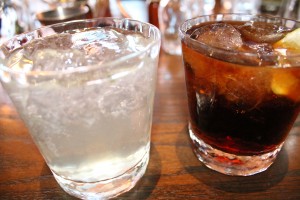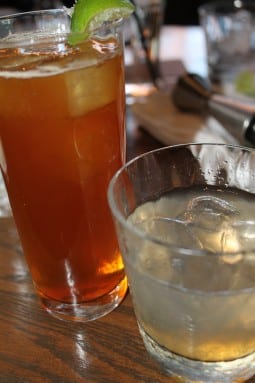I may not write about sports on a weekly basis (though next week’s Dallas Voice will be all about sports), but that doesn’t mean I don’t know how to follow a bracket. For this year’s March Madness, though, the bracket I’m following isn’t in NCAA Basketball, but in Cook Hall cocktails.
Cook Hall is the gastropub that replaced Craft down in the W Hotel last October, and their barstaff (Chad and Nick) came up with a Sweet Sixteen lineup of potent potables, paired off in a traditional bracket. And I got to be the judge. It wasn’t easy — four hours of tastings, over two days, all of which I had to prepare myself in their pretty-cool cocktail kits — but I took one for the team.
You can still partake and follow the bracket on Facebook (Cook Hall Dallas) and Twitter (@CookHall), or just come back here for the next few weeks and I’ll post the results.
After the jump, then, is Round One:
The first bracket matchup in this battle of the boozes has the luck to be between two giants of American literature — sort of. The Mark Twain (a simple scotch mix) versus the Ernest Hemingway … or as they call it, the Daiquiri. (Hemingway was a vocal fan of the drink from the early days, and even invented his own recipe.) The basic Daiquiri recipe at Cook Hall (rum, lime juice, simple syrup) encourages patrons to choose their own bitters from the house blends available; we squirted in a few drops of the red pear that comes with the kit. Still, that was no match for the smooth blend of scotch, lemon juice and simple syrup, with classic angostura bitters dripped in. Whiskey is a weakness. (I mixed up my own Mark Twain with bourbon that was equally good.) Victor: The Mark Twain.
 Moving down the bracket, we noticed quickly the tallest player on the Cook Hall lineup — the Dark and Stormy. Adding ginger beer to a slender glass filled with dark rum, you get the best world of the Moscow Mule with the rich sweetness of rum. The D&S had more reach than the Caipirosca, itself a simple mix of vodka and lime transformed by Demarara syrup, which imparts an unexpected complex mouthfeel in the base spirit. It has heart, but it’s the rum that packed the punch.
Moving down the bracket, we noticed quickly the tallest player on the Cook Hall lineup — the Dark and Stormy. Adding ginger beer to a slender glass filled with dark rum, you get the best world of the Moscow Mule with the rich sweetness of rum. The D&S had more reach than the Caipirosca, itself a simple mix of vodka and lime transformed by Demarara syrup, which imparts an unexpected complex mouthfeel in the base spirit. It has heart, but it’s the rum that packed the punch.
The Sour is a standby — the team captain, you might say — and Cook Hall’s suggestion is to pick the liquor of one’s choice. I made sure it was an even matchup against the Gin & Sin, an even fruitier blend of muddled orange, lemon and grenadine with a gin base. The G&S gets the jump on its competitor in complexity and sinfulness with balanced ingredients. (Full disclosure: I doubled the amount of muddled lemon and orange.)
Rounding out the top half of the bracket was the Ice Pick, vodka with berry tea accents — a brass version of the cosmo leads to a middle-of-the-pack face-off between it and the national drink of Texas, the Margarita. Of course the reliable Margarita plays great defense, and it’s a heartbreaker for the Ice Pick as tequila steals the ball from vodka.
The Pit Master, the top-seeded entrant on the bottom half of the bracket, tips off against the long-standing player The Tom Collins. It’s a battle of wills as the upstart bourbon-and-bitters challenges the wily elegance of the Collins. In overtime at the buzzer, it was the Pit by a lay-up.
The Shandy — a wheat bear rounded out with ginger beer and syrup, plus bitters to taste — is a perfect shared refresher as the weather starts to warm up. Wheat beer rarely suits my tastes on its own (most people add lemon or orange), and this one’s recipe had what it takes. Its competition was the Greyhound, the sourly atypical cousin of the Screwdriver, made with grapefruit juice instead of O.J., giving it a crisper, clean flavor. Here, with the added kick of grapefruit bitters, it rushes off the bench full of promise, but the Shandy proves to be the Cinderella story of the tourney.
 The Trinidad versus the Mojito is one of those pairing the NCAA always takes shit for in the early rounds — two evenly matched teams who compete for the same eyeballs (both rum drinks). The classic Mojito has an edge over the Trinidad (Cook Hall’s version of the Cuba Libre, with angostura bitters in addition to dark rum, Coke and lime). I tried mixing it up by inserting different bitters and even a tincture of fennel, but even giving the Trinidad a few foul shots couldn’t save it. The Mojito wiped the floor.
The Trinidad versus the Mojito is one of those pairing the NCAA always takes shit for in the early rounds — two evenly matched teams who compete for the same eyeballs (both rum drinks). The classic Mojito has an edge over the Trinidad (Cook Hall’s version of the Cuba Libre, with angostura bitters in addition to dark rum, Coke and lime). I tried mixing it up by inserting different bitters and even a tincture of fennel, but even giving the Trinidad a few foul shots couldn’t save it. The Mojito wiped the floor.
The final matchup on the bottom of the bracket was Mint Julep versus the “sparkling” kit. Cook Hall’s mixologist came up with a recipe here that’s sweeter — dare of call it girl-drink-like? — than the traditional julep. That’s by design: The gastropub wants to encourage experimentation with their tinctures and measuring kits (it’s one of the reasons they include a diary so you can write down and preserve your own recipes for future amateur barmen), so why no bitter it up if it’s tasting a bit sweet? Anyway, it mattered little — I’m a Southern boy, and we love our bourbon. I upped the alcohol-to-syrup ratio and sneaked in a few droplets of wormwood, and easily bested the defense offered by the split of Chandon decked out in syrup, orange and bitters.
Next week, I’ll work my way down the bracket, picking a winner over the Mark Twain vs. the D&D; the Gin & Sin vs. the Margarita; the Pit Master vs. the Shandy; and the Mojito vs. the Mint Julep.
Cheers!

















